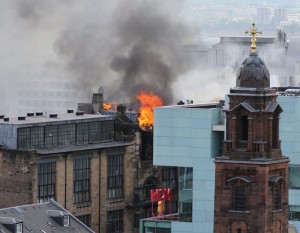
The tragic fire at the Glasgow School of Art, Charles Rennie Mackintosh’s masterpiece, raises anew the question: How to rebuild? In a thoughtful blog, George Cairns of Melbourne’s RMIT, who has studied the building in detail, points out that many undocumented changes were made during the building’s construction, so it will be impossible to recreate what was there. In addition, the inevitable demands of modern fire security will likely alter the original design. Rather than try to rebuild Mackintosh’s design, Cairns argues for “great architects to be invited to design a worthy intervention that will breathe new life into the school.”
I’m not so sure. When the fifteenth-century canal facade of the Doge’s Palace was destroyed by fire in 1577, Palladio proposed rebuilding it in a Classical style, but he was over-ridden, and the original Venetian Gothic was restored. When John Soane’s Dulwych Picture Gallery was hit by a V-1 rocket during WWII, it was rebuilt exactly as it had been. In fact, the building had been altered several times since Soane’s death. When the British House of Commons was gutted by fire during the Blitz, Giles Gilbert Scott rebuilt it in the spirit of Pugin’s original. A more recent example: Venice’s Teatro La Fenice. In 1996, the famous nineteenth-century opera house burned to the ground (arson), and was recreated virtually intact by Aldo Rossi, who used stills from a Visconti film as a guide.
Buildings are not works of art, time changes them, alterations regularly take place, life has its way. What’s wrong with repairing damage? Even if it is not exactly as it was, it could be almost as it was, and a hundred years from now, the difference will not matter. Surely that is better than a “worthy intervention”?

While I favour rebuilding in a likeness, I have questions about the feasibility. Is cost (budget) a factor in a similar rebuild in the context of modern code? Availability of skilled trades? Time? Would implementing a new design allow for better (more flexible) use of space and first-class energy efficiency? How might it end up being an improved version of the original?
I think we have a different set of criteria – and options – that need to be addressed in 2014 vs. 1577
Kindest, Andrea
I’m not sure what you mean by 1577. The library was built in 1907-09. The library of the University of Pennsylvania was designed by Frank Furness in 1888-90, and is likewise a masterwork. While it did not burn is was carelessly teated and insensitively altered by the university. In 1986-91, it was restored to its original state. Building skills and materials were not a problem. Environmental technology was updated. Key spaces were restored; less important spaces were altered. It did cost a lot of money: $16.5 million. It remains the most popular study space on campus.
1577 was your Doge’s Palace example. So, if I understand correctly, you’re suggesting that the only barrier to a period rebuild is ‘will’ of the powers that be?
Yes, will, and of course money. The renewed popularity of traditional architecture, particularly houses, has prompted a revival in the building handicrafts that has been quite remarkable. The much-maliged one-percenters have been the clients for much of this domestic work. What is interesting about Mackintosh’s library is that it was not a big-budget building, and the materials and details are often quite crude (unlike his high-end Hill House).
Ah, in that context I can see it being practical for this particular one-off building. Although there is some trades renaissance, there is still a mighty skills gap between the craftsmen/master builders and mainstream builders, at least in North America. We still need more effective, farther-reaching methodologies for ongoing skill transfer.
Thanks kindly, Andrea